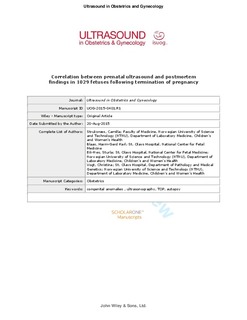Correlation between prenatal ultrasound and postmortem findings in 1029 fetuses following termination of pregnancy
Journal article, Peer reviewed
Permanent lenke
http://hdl.handle.net/11250/2428690Utgivelsesdato
2016Metadata
Vis full innførselSamlinger
Sammendrag
Objective: A prenatal ultrasound examination and a postmortem examination provide the basis for correct diagnosis in fetuses terminated due to congenital anomalies. The aim of this study was to correlate fetal anomalies detected by ultrasound examination with those identified at autopsy following termination of pregnancy (TOP) over a 30-year period, and to evaluate the correlation between findings at different gestational ages and assess these trends over time.
Methods: The study group consisted of 1029 TOPs performed over a 30-year period, from 1985 to 2014. The gestational age ranged between 11 and 33 weeks. Prenatal ultrasound examinations were performed at the National Center for Fetal Medicine, St Olavs Hospital, Trondheim, Norway. Autopsies were performed at the Department of Pathology and Medical Genetics at the same hospital or a collaborating hospital.
Results: There was full agreement between ultrasound and autopsy findings in 88.1% (907/1029) of TOPs, and the main diagnosis was correct in 97.9% (1007/1029). When comparing the 15-year period of 2000–2014 with that of 1985–1999, the difference in the rates of full agreement and agreement in the main diagnosis was statistically significant. In 1.3% (13/1029) of cases, ultrasound findings were not confirmed at autopsy. There were no false-positive diagnoses leading to TOP. Throughout the 30-year period, there was an increase in early TOPs, whereas late TOPs declined.
Conclusions: Our study demonstrates that there is a clear correlation between ultrasound and autopsy findings, which is continuously improving. Despite this high correlation, there is reason to continue the practice of validation to ensure the safety of the diagnostic process leading to TOP. The trend towards an earlier termination emphasizes the necessity of such a practice.
